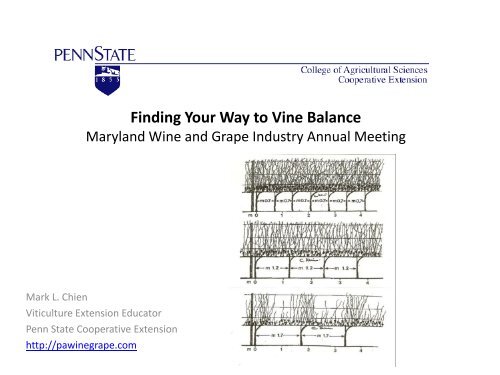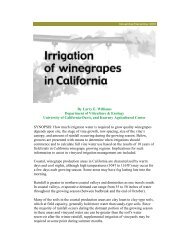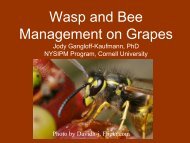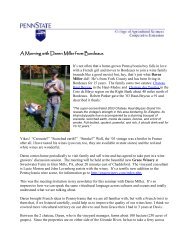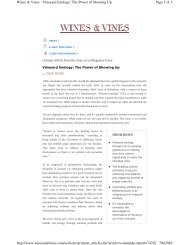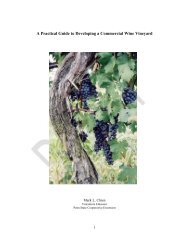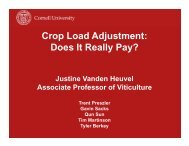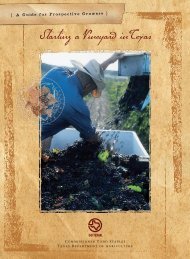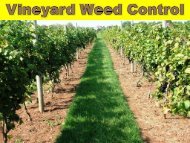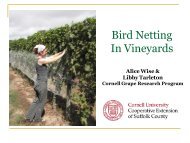Finding Your Way to Vine Balance - PA Wine Grape Network
Finding Your Way to Vine Balance - PA Wine Grape Network
Finding Your Way to Vine Balance - PA Wine Grape Network
You also want an ePaper? Increase the reach of your titles
YUMPU automatically turns print PDFs into web optimized ePapers that Google loves.
<strong>Finding</strong> <strong>Your</strong> <strong>Way</strong> <strong>to</strong> <strong>Vine</strong> <strong>Balance</strong><br />
Maryland <strong>Wine</strong> and <strong>Grape</strong> Industry Annual Meeting<br />
Mark L. Chien<br />
Viticulture Extension Educa<strong>to</strong>r<br />
Penn State Cooperative Extension<br />
http://pawinegrape.com
Pindar <strong>Vine</strong>yard, North Fork of Long Island<br />
Temperance Hill <strong>Vine</strong>yard, Willamette Valley, OR<br />
Fruit Research and Extension Center<br />
Adams County (near Gettysburg)
Our Common Viticultural Objectives<br />
• High quality wines of all types requires ripe and clean fruit<br />
• In the north vines must achieve maximum cold hardiness<br />
• In any given year, canopy and crop management (vine balance) can have<br />
more impact than any other inputs!<br />
• It works for all species, varieties, clones of grape vines intended <strong>to</strong> make<br />
good wine!<br />
Merlot on VSP at<br />
Waltz <strong>Vine</strong>yard in<br />
Manheim
It’s complicated: what wine growers are attempting <strong>to</strong> balance…<br />
Environmental and viticultural inputs that impact on grape quality and composition<br />
How does the wine grower bring these elements in<strong>to</strong> balance <strong>to</strong> create viticultural harmony,<br />
equilibrium, uniformity, synchronicity, and typicity in the vine and ecosystem.
Observations about <strong>Vine</strong> Size and <strong>Balance</strong><br />
• How big will a vine grow? Once you know, how do you<br />
balance it?<br />
• The process: careful site evaluation (determine capacity) ><br />
potential vine size > vineyard design (vine density and<br />
spacing) > viticulture (proper balance achieved through<br />
canopy and crop management)<br />
• Analyze the 3 dimensional vine for balance (depth, width and<br />
height
Two Choices for High Quality <strong>Wine</strong><br />
• Site is already selected: determine the wine that best matches<br />
the characteristics of the site. Eg. High capacity site > higher<br />
yields > production style wines.<br />
• Site is not yet selected: determine type, style and price point<br />
of wine desired. Seek the site with characteristics (capacity)<br />
that can fulfill the wine objectives. Eg. Ultra-premium fine<br />
wines > low yields > low <strong>to</strong> moderate capacity site.
Challenges <strong>to</strong> Achieving <strong>Balance</strong> in Maryland<br />
Making fine wine in the East. We have issues . . .<br />
• Better soil and climate mapping and experience <strong>to</strong> understand soil fertility<br />
and moisture<br />
• Poor site evaluation and improper vineyard design<br />
• Lack of viticulture experience and management skills.<br />
• Lucie Mor<strong>to</strong>n: s<strong>to</strong>p whining and start managing!<br />
• What does vine balance look and taste like in Maryland?
What is <strong>Vine</strong> <strong>Balance</strong>?<br />
• Justice Potter Stewart: … as with pornography, “I know it when I see it.”<br />
• Thinking backwards: start with the type, style and price point of the wine,<br />
• …then imagine the u<strong>to</strong>pian vine <strong>to</strong> achieve this wine.<br />
• …then work backwards <strong>to</strong>ward vineyard design <strong>to</strong> achieve a balanced vine.<br />
• Understanding the terroir <strong>to</strong> achieve balance: soil, climate, plant, viticulture<br />
• Then apply holistic, sustainable, creative, intelligent vineyard management<br />
• With experience you should be able<br />
<strong>to</strong> recognize a balanced vine
Yield and Quality: is the smallest vine with the<br />
tiniest yield the ultimate goal?<br />
• Diminishing return in quality<br />
• What is the perceptible quality difference<br />
• The Temperance Hill yield trial: 4 t/a, 3 t/a, 2 t/a, 1 t/a<br />
• Measuring yield per vine vs. yield per acre<br />
• In general, vine density is more important for red wine<br />
production than white wines<br />
• Internationally among balanced vines of all sizes, the best<br />
wines come from smaller vines with lower yields
A balanced vine can come in all different sizes…
Benchmarks of<br />
vine balance<br />
(small vines).<br />
Chateau Lafite-<br />
Rotschild in the<br />
Medoc.<br />
Why and how?
Large Merlot vines on vertically<br />
divided Scott Henry in balance at<br />
Paradocx <strong>Vine</strong>yard.<br />
Medium size vines at Black<br />
Ankle <strong>Vine</strong>yard in 2007. Very<br />
nice balance!<br />
When is a vine <strong>to</strong>o BIG?<br />
Or, <strong>to</strong>o small?
Big vines in Napa – pre-VSP<br />
12x8 spacing, 1 wire vertical<br />
California sprawl system. Are<br />
they in balance?
Cesare at Robert Voerzio in<br />
Barolo – Nebbiolo at 70cm<br />
Chateau Ausone in St Emilion – Merlot<br />
At 20,000 vines per hectare (8000/ac)
<strong>Balance</strong> is achieved before the vines are planted:<br />
modesty is the best policy!<br />
• Again, start with the wine: type, style, and price point<br />
• Site selection: the single most important decision for a vineyard<br />
• <strong>Vine</strong> size: SO important. The goal is <strong>to</strong> grow a vine whose size meets the<br />
wine type, style and price point goals<br />
• Site evaluation: determining potential vine size so balance can be<br />
designed in<strong>to</strong> the vineyard. What is the soil capacity?<br />
– Plant available water: especially the amount and distribution during<br />
the growing season (drainage and slope)<br />
– Soil fertility: moderate nutrient levels, especially nitrogen, also pH<br />
• Choose the appropriate variety/clone AND roots<strong>to</strong>ck<br />
• Design the vineyard – IN ROW S<strong>PA</strong>CING!!<br />
• Plant vines. See what happens. Apply viticulture.
Influence of vine spacing on canopy architecture<br />
Too Narrow<br />
Optimum<br />
Keep it open, but not <strong>to</strong>o open<br />
Too Wide<br />
From: Intrieri and Filipetti American Journal of Enology and<br />
Viticulture, 50 th Anniversary. Taken from a talk by Dr. Jim Wolpert.
Wouldn’t it be Great <strong>to</strong> do Nothing<br />
• Viticulture is a band-aid for poor site selection that results in<br />
poor vine balance. Intervention in the vineyard and cellar is a<br />
weakness, not a strength.<br />
• BUT: viticulture has great power <strong>to</strong> overcome a poor site and<br />
design – e.g. Bordeaux garagistes, Karamoor Farm
Viticulture vs. Site<br />
• Vigorous site? Who cares. Just manage it.<br />
• Great site. The wine makes itself.<br />
• Is one better than the other?<br />
• We are in the viticulture period of an emerging wine region.<br />
• Jim Law opinion: site and viticulture<br />
• The Williams Seylem Allen vineyard example
Nelson Stewart at<br />
Karamoor Farm<br />
Not ideal<br />
sites but<br />
great wine<br />
anyway.<br />
Maximum<br />
viticulture!<br />
Jean-Luc Thunevin at Chateau Valandraud in St Emilion
Good <strong>Balance</strong> Good Canopy Good <strong>Wine</strong><br />
• Enhancing the microclimate of the vine: entry of light and air in<strong>to</strong> the canopy<br />
environment offers…<br />
– Lower incidence of almost all diseases by reducing humidity levels and<br />
allowing sunlight and wind <strong>to</strong> dry out leaves and fruit<br />
– Improve spray penetration <strong>to</strong> interior of the canopy<br />
– Allows sunlight <strong>to</strong> penetrate in<strong>to</strong> the canopy interior for more efficient<br />
pho<strong>to</strong>synthesis<br />
– Affects fruit zone temperature range allowing more efficient biosynthesis<br />
of essential compounds<br />
– Helps <strong>to</strong> reduce levels of methoxypyrazines (green, herbal flavors in red<br />
wines) in berries<br />
– Looks better, makes the grapes appear/are better quality and thus wine.<br />
<strong>Wine</strong> makes like tidy canopies for their wines
The Crystal Ball: a soil pit and a very smart person<br />
What is the soil capacity and potential vine size?
<strong>Vine</strong>yard design will determine vine balance<br />
• Plant materials<br />
– Varieties: natives and hybrids are naturally more disease resistant<br />
– <strong>Vine</strong> morphology: small leaves, loose clusters, internode length<br />
– Natural vine vigor: e.g. Cabernet Sauvignon vs. Pinot Noir<br />
– Roots<strong>to</strong>ck effects on vine size and vigor<br />
– Plant healthy, certified vines and then take care of them!<br />
• Trellis and training systems<br />
– Single or divided canopies<br />
– Head/cane vs. cordon/spur pruning and training<br />
– Fruit wire height: effects on microclimate<br />
– Overall canopy height: can the spray material reach the <strong>to</strong>p<br />
• Spacing decisions<br />
– Between vines: quality<br />
– Between rows: quantity
<strong>Vine</strong> Density: fitting the vine in<strong>to</strong> the right space<br />
• Harmony, equilibrium and balance in the canopy<br />
• It is better <strong>to</strong> give a vine <strong>to</strong>o much space than <strong>to</strong>o little<br />
• Distance between rows determines quantity<br />
• Distance between vines determines quality<br />
Juan in 1m x 1m at Mondavi<br />
Lyre system on 12x6 in Napa
Measuring <strong>Vine</strong> <strong>Balance</strong><br />
• <strong>Grape</strong> and wine quality tell you the s<strong>to</strong>ry of the vine<br />
• Lucie Mor<strong>to</strong>n: know what it looks like<br />
• Richard Smart’s Golden Rules (for mature vines)<br />
– 4-5 shoots per foot<br />
– 0.2-0.4 lb pruning wt per foot<br />
– Canes 20-40 grams (0.8 <strong>to</strong> 1.5 oz) per cane<br />
– 5-10:1 ratio fruit <strong>to</strong> pruning wt<br />
• 1 <strong>to</strong> 1.5 leaf layers helps all problems with disease!<br />
– Dappled light.<br />
– The t-shirt effect.<br />
– Check the shadow in mid morning and afternoon<br />
• Shoots evenly spaced, proper length and diameter
A balanced vine and vineyard looks balanced
A <strong>Balance</strong>d <strong>Vine</strong> According <strong>to</strong> Mark Chien<br />
• For premium hybrid and vinifera wines growing on VSP:<br />
• Majority of shoots are . . .<br />
– the same length<br />
– about 50 inches long<br />
– no bull canes, few stunted ones (average weight 1-1.5 oz)<br />
• Other considerations:<br />
– 2-5 shoots per foot of trellis<br />
– 0-1 hedging passes per season<br />
– Some leaf removal on the morning side<br />
– 2 clusters or fewer per shoot reach optimal maturity with some yield<br />
adjustment
More Measures of <strong>Balance</strong><br />
• The scientific target: 12-15cm² leaf area per gram of<br />
fruit. Only graduate students do this.<br />
• Determine the ideal shoot number and length based<br />
on 3 dimensions of canopy<br />
• Understand when a canopy is <strong>to</strong>o dense or <strong>to</strong>o thin<br />
• Set the proper yield for consistently ripe fruit<br />
• How does spacing between rows and vines affect<br />
balance?
Canopy Management Practices<br />
• Dormant pruning: it all starts here. Get the bud numbers right<br />
• Manage the vine head and cane/cordon ends carefully<br />
• Manage suckers<br />
• If you have more than one cane or cordon or any combination per side of<br />
vine, manage them according <strong>to</strong> shoots per linear distance<br />
• June in the East is the critical month for vine balance (Jim Law). Be ready<br />
for it!<br />
• Shoot position like you mean it. The more vigorous a vine, the more<br />
important shoot positioning becomes!<br />
• Exposure and aeration comes from leaf and lateral removal, shoot and<br />
cluster positioning, tunneling if a very vigorous canopy<br />
• Hedge as much as you need <strong>to</strong>, no more or less<br />
• Correct timing of positioning and wire placement is oh, OH so critical <strong>to</strong><br />
success!!!
Find and Emulate Good Canopies<br />
Vertical shoot positioned Pinot Noir at Chaddsford
Marquette on high wire cane pruned at Lincoln Peak <strong>Vine</strong>yard in Vermont
When <strong>to</strong> Divide (or undivide)<br />
• Greater (or less) than 0.4-0.5 lb of pruning weight per foot of trellis<br />
• Vertical: Scott Henry<br />
• Horizontal: Lyre (Alain Carbonneau)<br />
• Developing the divided trellis and training system<br />
• It’s not as complicated and expensive as it looks, or you have been <strong>to</strong>ld
Scott Henry training at<br />
Paradocx <strong>Vine</strong>yard in<br />
Chester County
Perfectly trained Nor<strong>to</strong>n on Geneva Double Curtain<br />
at Chrysalis <strong>Vine</strong>yard in Virginia
Veraison and Harvest: crunch time for canopies<br />
• S<strong>to</strong>p those shoot tips from growing! How? Any way you can!<br />
– See Gill Giese and Tony Wolf research<br />
• Late whites and reds still need good canopies for 4-6 weeks<br />
– Disease control, especially PM, DM and late harvest rots<br />
• Getting the fruit fully mature. Fruit zone architecture<br />
• Building up carbohydrate (flesh and fuel) for overwintering<br />
and spring growth
Don’t Forget the Fruit!<br />
• Find the sweet spot of foliage-fruit balance<br />
• Keep clusters well spaced and separated (i.e. shoots positioned)<br />
• Fruit zone open <strong>to</strong> allow spray penetration<br />
• Effectiveness of late season sprays<br />
• Critical temperature needs related <strong>to</strong> fruit ripening processes<br />
– Pho<strong>to</strong>synthesis<br />
– Flavors, color, tannin, methoxypyrazines<br />
Merlot in Maryland<br />
Pinot Noir in Ontario
<strong>Vine</strong> <strong>Balance</strong> = People<br />
• Skilled labor and supervision<br />
– Have the people ready when you need them<br />
– Be out there working with the crew<br />
– Have the money available <strong>to</strong> pay the crew<br />
• Timing is absolutely critical <strong>to</strong> successful canopy management<br />
– Early tasks<br />
– Watch and understand the weather<br />
– Grand period of growth. Be ready!<br />
– Post-veraison canopy and crop management<br />
• Labor costs are typically 50-70 percent of vineyard operating<br />
expenses. Be prepared!
Ideas for Maryland <strong>Vine</strong> <strong>Balance</strong><br />
• Head for the hills! Steep, shallow, rocky soils and cooler<br />
temperatures.<br />
• Rigorous site evaluation and vineyard design<br />
• If necessary divide the vine for balance, make better wine and<br />
more of it!<br />
• Black Ankle: the vines appeared <strong>to</strong> be in balance. What are<br />
the conditions that achieve balance?<br />
• Focus on site selection according <strong>to</strong> wine type, style and price<br />
• Apply the absolute best viticulture possible <strong>to</strong> all vines
Further Information . . .<br />
• Dr. Richard Smart: Sunlight in<strong>to</strong> <strong>Wine</strong><br />
• Dr. Mark Greenspan, Advanced Viticulture:<br />
http://www.winebusiness.com/wbm/?go=getArticle&dataId=70706<br />
• Dr. Jim Wolpert, UC-Davis:<br />
http://cop.extension.org/wiki/<strong>Vine</strong>_<strong>Balance</strong>_and_the_Role_of_<strong>Vine</strong>yard_Design<br />
• Dr. Patty Skinkis, Oregon State University:<br />
http://cop.extension.org/wiki/Basic_Concept_of_<strong>Vine</strong>_<strong>Balance</strong>
http://pawinegrape.com
Thank you for<br />
your attention<br />
Mark L. Chien<br />
Viticulture Extension Educa<strong>to</strong>r<br />
Penn State Cooperative Extension<br />
http://pawinegrape.com


